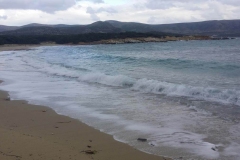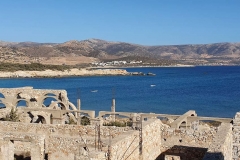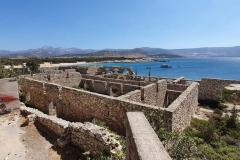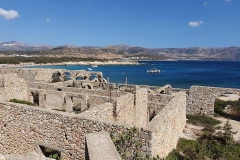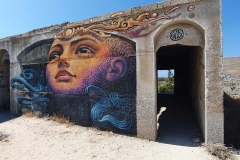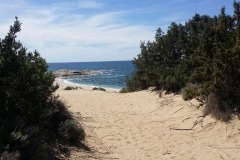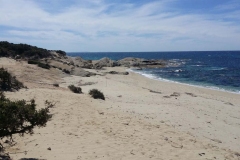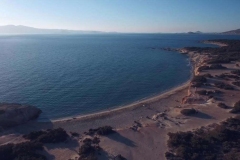Alyko beach, is located in the SW of Naxos, 18 Km from Naxos capital and port. Alyko beach is one of the most beautiful beaches of the island, with white sand, and the Kedrodasos, a large dense cedar tree forest area with marvelous sand dunes. The Kedrodasos forest is declared a protected Natura area.
Alyko beach is the safe haven eveyone goes to swim when meltemia winds blow in the Aegean Sea. It’s an ideal beach for those who seek isolation, although it gets crowded during high season. It’s not an organized beach, there are no umbrellas or sunbeds available for rent, so make sure you bring your own. The route to Alyko beach offers panoramic views of the entire coastal area from Mikri Vigla to the peninsula of Alyko itself. Find here a few hotels, studios, excellent taverns, and a market. Access to Alyko beach is made via asphalt road. Public transportation is available several times a day.
Alyko beach is must visit while in Naxos
The street art at Alyko
Worth visiting while at Alyko beach, is the abandoned hotel complex, and the work of “WD Street Art”. Near the lush sandy beach there is the ruins of an uncompleted hotel from the 1960s/1970s that has been repurposed as a street art museum. Here you will see magnificent works of the famous street artist WD (Wild Drawing) as well as of some other street artists in a colorful ode to open-air art. This decaying buildings provide amazing photographic opportunities at this wonderful beach location on the West coast of Naxos, Greece.
Kedrodasos Alykou
The nature of Naxos talks to the heart of every artist with its authenticity, richness, diversity and simplicity. A very particular pristine environmental profile of Naxos is the Kedrodasos of Alykou – in southwestern Naxos, is home to one of Greece’s largest and densest juniper forests. A huge land mass of approximately 200 acres, this peninsula is covered with aged old juniper trees, lentisc shrubs, heather, thyme, calycotomes and various wild flowers. It has received international recognition and Greece has included this part of the island in the European network of protected areas Natura 2000.
The Juniper trees that cover the peninsula’s greatest part, are gymnosperm coniferous trees belonging to the Pinales category and the Cupressaceae family. Their lifespan ranges between 200-300 years, and they measure up to 6 meters in height with a diameter of up to 1 meter. The root system of junipers stretches out in a radius of at least double their respective height and includes an enormous amount of small and slender webbed roots that hold the sand and thereby maintain surrounding sand-dune formations. The Alyko juniper forest attracts wild life and is a natural habitat for hares, reptiles, and numerous bird species.
The Natural 2000 protected areas in Naxos include also an additional network in central and southern sections of the island, and that includes Mount Zas (Zeus), the areas from Vigla to Mavrovouni and the area between the bays of Karades and Moutsouna.

